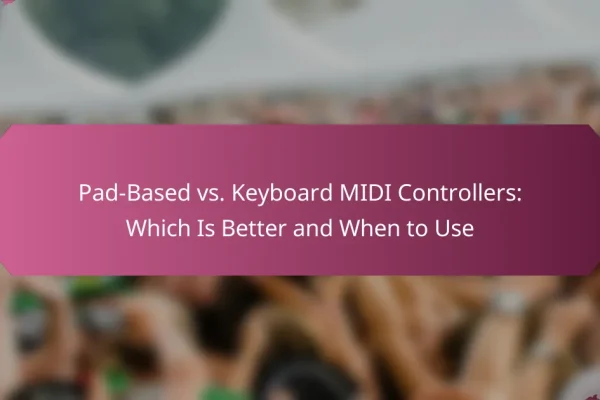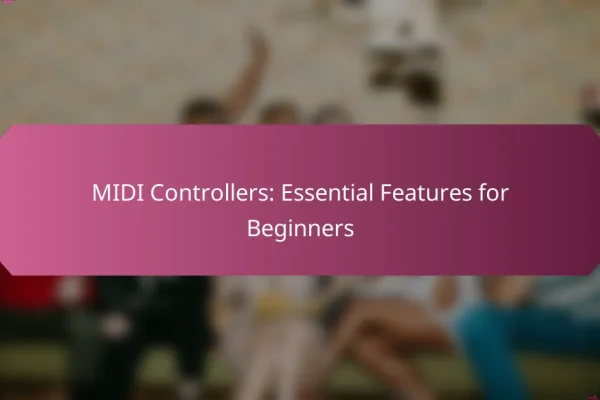How do MIDI controllers enhance music production?
MIDI controllers enhance music production by providing musicians with intuitive tools for creating and manipulating sounds. They allow for greater precision and flexibility in composing, recording, and performing music.
Improved workflow efficiency
MIDI controllers streamline the music production process by enabling quick access to various functions and controls. This efficiency is achieved through features like programmable knobs, sliders, and pads that can be customized for specific tasks, reducing the time spent navigating software menus.
For instance, using a MIDI controller, a producer can adjust multiple parameters simultaneously, such as volume levels and effects, which can significantly speed up the mixing process. This leads to a more fluid creative experience, allowing artists to focus on their music rather than technical details.
Creative expression through tactile control
The tactile nature of MIDI controllers fosters creative expression by allowing musicians to interact physically with their music. This hands-on approach can inspire new ideas and facilitate spontaneous creativity, as performers can manipulate sounds in real-time.
For example, playing a MIDI keyboard can evoke different emotions compared to programming notes on a screen. The ability to control dynamics and articulation through touch adds a layer of expressiveness that enhances the overall musical output.
Integration with DAWs like Ableton Live
MIDI controllers are designed to integrate seamlessly with digital audio workstations (DAWs) such as Ableton Live, making them essential tools for modern music production. This integration allows for direct control over software instruments and effects, enhancing the creative workflow.
Many MIDI controllers come with pre-mapped settings for popular DAWs, enabling users to start making music right away without extensive setup. Additionally, features like clip launching and session view control in Ableton Live can be easily accessed, allowing for dynamic live performances and efficient song arrangement.
What are the best MIDI controllers for beginners?
The best MIDI controllers for beginners are typically compact, user-friendly, and affordable. They should offer essential features like velocity-sensitive keys and assignable controls to facilitate learning and creativity in music production.
Akai MPK Mini MK3
The Akai MPK Mini MK3 is a highly regarded MIDI controller that combines portability with functionality. It features 25 velocity-sensitive keys, eight backlit drum pads, and eight assignable knobs, making it ideal for both composing and performing music.
One of its standout features is the built-in arpeggiator, which allows users to create complex musical patterns easily. Additionally, it comes with a software bundle that includes popular music production software, enhancing its value for beginners.
Novation Launchkey Mini MK3
The Novation Launchkey Mini MK3 is another excellent choice for novice music producers, offering 25 keys, 16 RGB pads, and eight rotary knobs. Its integration with major DAWs like Ableton Live makes it particularly appealing for users looking to streamline their workflow.
This controller also includes a chord mode, allowing users to play chords with a single key press, which is great for those still mastering music theory. With its lightweight design and comprehensive software package, it’s a practical option for beginners aiming to create music on the go.
How to choose the right MIDI controller for your needs?
Choosing the right MIDI controller involves assessing your specific music production needs, including the type of music you create and your workflow preferences. Consider factors such as key count, pad sensitivity, and software compatibility to ensure you select a controller that enhances your creative process.
Consider key count and size
The key count and size of a MIDI controller significantly influence your playing experience. Controllers typically range from 25 to 88 keys, with smaller models being more portable and larger ones offering a full piano experience. If you often play complex melodies or chords, a larger key count may be beneficial.
Additionally, consider the key size. Full-sized keys mimic a traditional piano, while mini keys can be more compact and easier to transport. Think about how much space you have in your studio or performance setup when making your choice.
Evaluate pad sensitivity and features
Pad sensitivity is crucial for expressive playing, especially for genres like hip-hop or electronic music. Look for controllers with velocity-sensitive pads that respond to your playing dynamics, allowing for more nuanced performances. Some controllers also offer aftertouch, which adds another layer of expressiveness.
Features such as assignable knobs, sliders, and transport controls can enhance your workflow. Consider what additional functionalities you need for your production style, as these can streamline your process and improve your overall efficiency.
Assess compatibility with software
Ensure that the MIDI controller you choose is compatible with your preferred music production software. Most controllers work with popular DAWs like Ableton Live, Logic Pro, and FL Studio, but it’s wise to check for specific compatibility or included software bundles.
Some controllers come with built-in presets for various software, which can save time during setup. Additionally, consider whether the controller supports MIDI over USB or traditional MIDI connections, depending on your studio setup and equipment.
What are the key features of professional MIDI controllers?
Professional MIDI controllers are designed to enhance music production by providing essential features that improve workflow and creativity. Key features include velocity-sensitive keys, customizable controls, and built-in audio interfaces, all of which contribute to a more intuitive and responsive music-making experience.
Velocity-sensitive keys
Velocity-sensitive keys respond to the force with which they are pressed, allowing for expressive playing that mimics the dynamics of acoustic instruments. This feature is crucial for creating nuanced performances, as it enables variations in volume and tone based on how hard or soft the keys are struck.
When selecting a MIDI controller, consider the number of keys and their sensitivity range. Most professional models offer a range of 25 to 88 keys, with varying degrees of sensitivity that can be adjusted to suit personal playing styles. Look for options that allow for aftertouch, which adds another layer of expressiveness by responding to pressure applied after the initial key press.
Customizable controls and mappings
Customizable controls and mappings allow users to tailor the MIDI controller to their specific workflow and preferences. This includes assigning knobs, faders, and buttons to various functions in music production software, enabling quick access to frequently used parameters.
Many MIDI controllers come with software that simplifies the mapping process. Users can create profiles for different software applications, ensuring that their setup is optimized for each project. Be cautious of controllers with limited mapping options, as this can hinder flexibility during production sessions.
Built-in audio interfaces
Built-in audio interfaces in MIDI controllers streamline the music production process by eliminating the need for separate equipment. These interfaces convert audio signals into digital data, allowing for direct recording and playback through the controller.
When choosing a MIDI controller with an audio interface, check the input and output options, as well as the quality of the audio conversion. Look for controllers that support common audio formats and sample rates, ensuring compatibility with your digital audio workstation (DAW). A good interface can significantly enhance sound quality and reduce latency, making it a valuable feature for serious producers.
How do MIDI controllers compare to traditional instruments?
MIDI controllers offer a different approach to music production compared to traditional instruments. While traditional instruments produce sound directly, MIDI controllers send digital signals to software or hardware synthesizers, allowing for a wide range of sounds and effects.
Flexibility in sound design
MIDI controllers excel in sound design flexibility, enabling musicians to manipulate sounds in ways that traditional instruments cannot. Users can easily switch between different virtual instruments, apply various effects, and layer sounds to create unique compositions.
This flexibility allows for experimentation with genres and styles, making it easier to achieve desired sonic characteristics. For instance, a MIDI controller can be used to emulate the sound of a piano, strings, or even electronic beats, all within the same session.
Portability and convenience
Portability is a significant advantage of MIDI controllers, as they are typically lightweight and compact compared to traditional instruments. This makes them ideal for musicians on the go, allowing for easy transport to studios, gigs, or practice spaces.
Additionally, MIDI controllers often come with built-in features like pads, knobs, and sliders that streamline the music production process. This convenience enables users to control multiple parameters without needing extensive setups, making it easier to focus on creativity rather than logistics.
What are the emerging trends in MIDI controller technology?
Emerging trends in MIDI controller technology focus on increased integration with software, enhanced portability, and advanced features like touch sensitivity and customizable controls. These developments cater to both professional producers and hobbyists, making music production more accessible and versatile.
Increased integration with software
Modern MIDI controllers are increasingly designed to work seamlessly with popular digital audio workstations (DAWs) such as Ableton Live, Logic Pro, and FL Studio. This integration often includes dedicated controls for software functions, allowing users to manipulate parameters directly from the controller without needing to switch between devices.
For instance, many controllers now feature pre-mapped controls for specific DAWs, enabling users to start producing music right out of the box. This trend reduces setup time and enhances workflow efficiency, making it easier for musicians to focus on creativity.
Enhanced portability
Portability has become a key consideration in MIDI controller design, with many manufacturers producing lightweight and compact models. These controllers are ideal for musicians who travel or perform live, as they can easily fit into a backpack or carry-on luggage.
For example, portable MIDI keyboards often come with battery power options, allowing for use in various locations without needing a power outlet. This flexibility is essential for artists who want to create music on the go.
Advanced features like touch sensitivity
Touch sensitivity and pressure-responsive pads are becoming standard features in many MIDI controllers, providing a more expressive playing experience. These features allow musicians to control dynamics and articulation, making performances feel more natural and nuanced.
Controllers with velocity-sensitive keys or pads enable users to vary the intensity of their playing, which is crucial for genres that rely on expressive musicality. When choosing a MIDI controller, consider models that offer these advanced features to enhance your production capabilities.
Customizable controls
Customizable controls are increasingly popular, allowing users to tailor their MIDI controllers to their specific workflow. Many controllers now offer assignable knobs, faders, and buttons that can be mapped to various functions within a DAW.
This level of customization enables musicians to create a personalized setup that suits their unique production style. When selecting a MIDI controller, look for options that provide easy mapping and configuration to maximize your efficiency in the studio.








